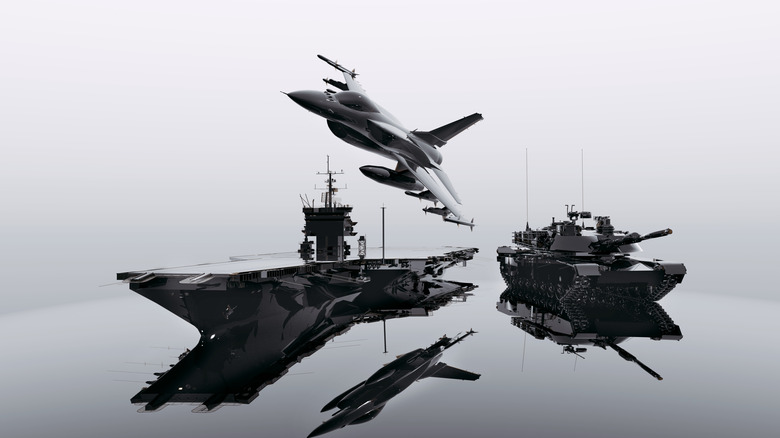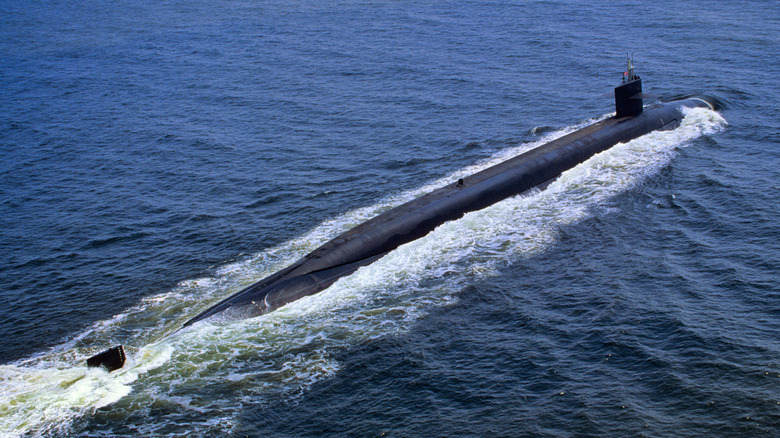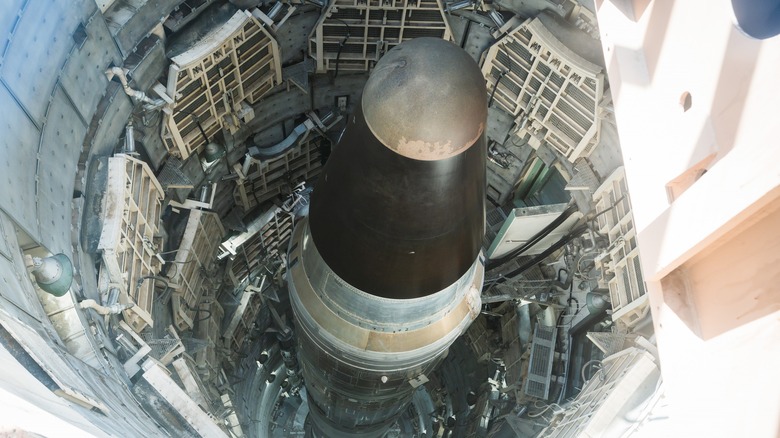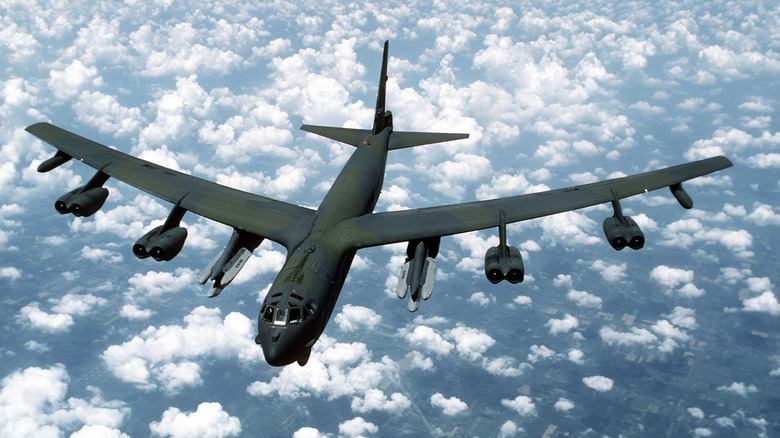How Does The US Nuclear Triad Work?
Many know the phrase "mutually assured destruction." That phrase can be applied to many different scenarios, but it's most commonly attached to the use of nuclear weapons. It's the idea that the threat of retaliation with nuclear weapons will keep other nations from using their nuclear weapons. It's a standstill that has worked so far. The United States of America has thousands of nuclear weapons at its disposal that it keeps all across the globe. When one refers to the nuclear triad, they're referring to the three different "legs" that make up the delivery method for those nuclear weapons. America's nuclear triad warheads can be mounted onto bombs and missiles launched from the air, the sea, and the land.
Having such a robust system ensures that America will always have a way to retaliate against a nuclear attack even if one or two of the legs are taken out. As of 2021, the country has roughly 3,800 nuclear warheads in its arsenal. It used to be around 5,000, but a good chunk of the inventory has been scaled back and await dismantlement. There are roughly 400 silos designed to launch nuclear warheads, with 14 submarines covering the sea portion of the triad, and 66 bombers and fighter jets for the air leg.
Submarines are the best hidden launch platforms
The sea leg of the nuclear triad consists of its 14 Ohio-class submarines. These are ballistic submarines (SSBN), often referred to as boomers, and they're considered the cornerstone to national security. They're designed to be stealthy and are on constant patrol. When we say constant, we mean constant. Not only are there several boomers on patrol at all times, every boat has two crews (blue and gold team). When one team is off, the other is on. They'll stay out at sea for roughly 77 days, return to port where the boat will receive repairs for about 35 days, and then the other team will take it out for patrol. Being nuclear-powered vessels, they could technically stay out longer. But the crew is only human.
These submarines have the ability to carry and launch 20 submarine-launched ballistic missiles (SLBMs) that have a range of 4,600 miles. When you have a missile with that kind of range on a mobile, undetectable platform, they can strike anywhere in the world even if the target is landlocked. They used to carry 24 SLBMs, but the New Strategic Arms Treaty required a reduction in nuclear armament, so four missile tubes were permanently deactivated. They can officially dive as deep as 800-feet, but there are those who believe it can go as far as 1,500-feet deep. The Ohio SSBNs are slated to be replaced by the new Columbia-class SSBNs sometime in the 2030s.
If not by sea, then by land
Just as SSBNs carry submarine-launched ballistic missiles (SLBMs), the continental US is filled with silos armed with intercontinental ballistic missiles (ICBMs) known as Minuteman III missiles. There are 400 Minuteman III missiles spread across Montana, Wyoming, North Dakota, and Colorado and they're always ready to launch at a moment's notice. Being "intercontinental" they have the range to reach other continents. More than 6,000 miles, to be exact. They can also go as high as 700 miles and reach speeds of 15,000 miles per hour, or Mach 23. With the capacity to carry up to three nuclear warheads, the damage a Minuteman III would cause would be unlike anything a person has seen.
There are plans underway to modernize these ICBMs, replacing them with the LGM-35A Sentinel missiles as well as a modernization of the launch facilities. ICBM silos are the most vulnerable nuclear platform of the triad due to their stationary nature. That's why the triad exists, however, because even if no ICBM sites could launch, there are two other legs as a backup. These land-based platforms are known as a "nuclear sponge."
According to Joseph Cirincione, retired president of the Ploughshares fund and former director of nonproliferation at the Carnegie Endowment for International Peace told Wired, "Because a major justification for the program is that it would do exactly that, it would force the adversary to target these warheads ... they're counting on the adversary thinking about it." This is why many voters think the Pentagon should do away with this entire leg of the triad.
The air leg has plenty of options
The two main platforms designed to launch nuclear missiles from the air are the B-2 Spirit stealth bomber and the B-52H Stratofortress. The F-16 Falcon was the primary nuclear capable fighter jet, but as of March 2024, the F-35 Lightning II has been certified to carry nuclear bombs. The nuclear weapons used by planes are either a nuclear air-launched cruise missile (ALCM) or a gravity bomb. ALCMs can be launched from a distance of about 1,500 miles and are known for their accuracy while nuclear gravity bombs need to be dropped closer to the target.
There are 20 B-2s and 46 B-52s in the USAF arsenal with the B-52 equipped to launch 12 AGM-129 advanced cruise missiles and 20 AGM-86A nuclear-tipped ALCMs while the B-2 carries those and the B61-11 and B-83 gravity bombs. The B61-11 is typically meant for targets that are deeper underground. However, both bombers are prepared to be phased out as Northrop Grumman is in the process of developing the B-21 Raider, a new stealth bomber that promises to be more advanced than its B-2 predecessor.
The Air Force has plans to develop new B61 nuclear bombs to extend the bomb's lifespan by 20 years. The B61-12 will be designed with a low-yield nuclear warhead that should minimize collateral damage and will be completed in 2025. Furthermore, there's also the development of the the Long Range Standoff Weapon (LRSO), a new nuclear cruise missile that will replace the aging AGM-86B ALCM.



